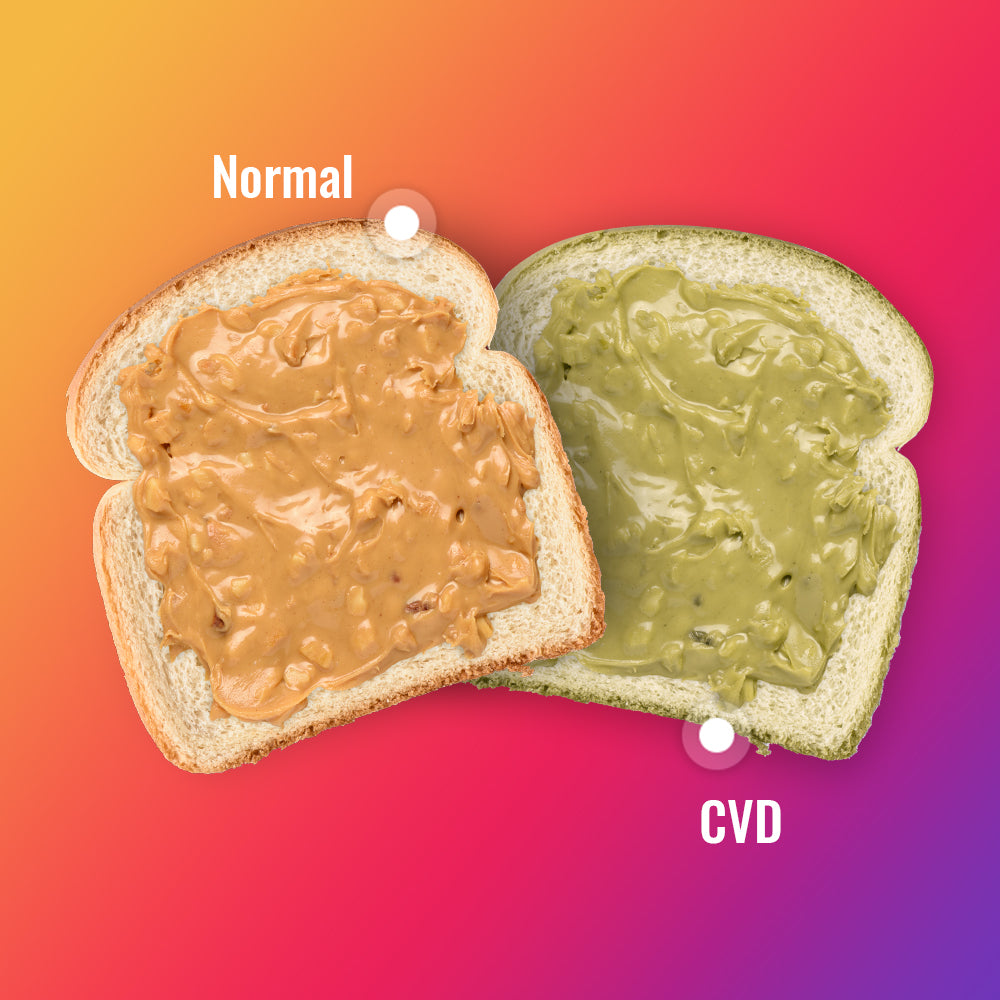Color. It affects every part of our lives. Color is emotional, experiential, and tactical. It gives art life. It entices us to eat certain foods and buy certain jewelry, and sometimes it literally defines these things. We also use color to interpret information such as signs and lights. It is deeply ingrained in our basic perception of the world. When the ability to see color is deficient, as in the case of color blindness, there is a dulling of what is seen; or one might say there is a dulling effect in how we see.
Definition of Color Blindness (Color Vision Deficiency)
What is color blindness? Color blindness is a reduced ability to distinguish between colors when compared to the standard for normal human color vision. When a person is color blind, also called color vision deficiency (CVD), they usually have difficulty distinguishing between certain colors such as yellow and orange, green and brown, pink and gray, or blue and purple. These confusions are typical of what is called “red-green color blindness,” which includes protan-type CVD (protanomaly and protanopia) and deutan-type CVD (deuteranomaly and deuteranopia).
Red-green color blindness is usually inherited via X-linked recessive genes. Other types of color blindness exist also, such as tritan-type CVD, also called blue-yellow color blindness, which is associated with the inability to see shades of blue, and confusions between blue and green colors. Blue-yellow color blindness is usually caused by age-related eye conditions such as glaucoma, or exposure to certain chemicals or medical treatments. In very rare cases, a person can be completely color blind, meaning they see only the intensity of light, but not its color. This is called monochromacy or achromatopsia. Achromatopsia can be inherited but can also result from progressive eye diseases such as retinitis pigmentosa. In summary, there are many types and degrees of what can be considered “color blindness,” ranging from partial to complete lack of color discrimination.
To learn if you are color blind, take the EnChroma Color Blind Test. If you have color blindness, our test can tell you your type of color vision and if your color vision deficiency is mild, moderate, or strong — in less than two minutes.
How Many People Are Color Blind?
There are an estimated 350 million people in the world with red-green color blindness (deutan-type and protan-type vision deficiency), or 4% of the total population. Red-green color blindness is acquired genetically through your parents and is expressed by genes on the X-chromosome. Because of the X-linked recessive biology behind red-green color blindness, the condition affects mainly men: about one in 12 men (8%), but also includes about one in 200 women (.5%). Read more about the genetics of color blindness.
Less precise statistics are known about blue-yellow color deficiency, which is most often caused by progressive or age-related eye conditions. Some estimates place the total number at least as high as those for red-green color blindness, and may be increasing due to the trend toward an aging population demographic worldwide.
The more rare forms of color blindness include achromatopsia and progressive eye diseases, such as retinitis pigmentosa. Estimates of these conditions are about 1 in 2000 people, or lower, but are known to be greater in certain subpopulations.
What Causes Color Blindness?
The most common types of color blindness are the red-green types which are also called protan ("pro-tan") color blindness and deutan (“do-tan”) color blindness (see Types of Color Blindness for more information about these). Red-green color blindness is an inherited condition caused by recessive genes on the X-chromosome. These genes cause a molecular substitution to be expressed in the retinal photopigment molecule, which in turn, causes its spectral absorption to be shifted in such a way that the available information is reduced (we also call this an “overlap”).
Color vision also declines with age. Studies have shown the Total Error Score on the FM-100 color vision test increases from about 100 at age 20 to over 200 by age 70.
Color blindness and color vision deficiency can also be caused by natural aging processes in the eye, and by low vision disorders such as glaucoma, cataracts, and macular degeneration, as well as metabolic and vascular diseases.
Color vision loss can also be a side effect of drugs, or a result from exposure to neuro-toxic chemicals such as styrene, perchloroethylene, toluene, carbon disulfide, n-hexane, and mercury.
How Spectral Overlap Causes Color Blindness
Our eyes have two kinds of specialized light receptors (rods and cones) located in the retina in the back layer of the eye to help us see. Rods allow us to see in low light conditions, like at night. Cones allow us to see in bright light, like during the day—and convert light into color vision.
There are three kinds of cones that translate light into color, each with a range of sensitivity to blues, greens, and reds. If we look at the cones of a person with typical color vision, their cones will be arranged in a way that is only slightly overlapping, as seen in the graph below. The three separate regions of color response enable human color vision to see up to 1 million distinct shades of color. In people with color blindness (specifically, red-green color blindness), there is a greater overlap, sometimes to the point of complete overlap, between the red and green cones.
When the curve of the cone sensitive to greens shifts its sensitivity to the right, it causes an excessive overlap of the green and red making the green cone act more like a red cone (this describes deutan-type color blindness; for protan-type the red cone shifts to the left). Because this cone is no longer sensitive to the greens and other wavelengths that help to make up more colors, this reduces the colors seen and causes a dullness in the way the world's colors appear. Instead of responding separately to reds and greens, the red and green cones’ responses are highly similar. This result is color confusion between specific colors, including blue versus purple, and green versus brown, yellow, orange, and red. That’s why some people with color blindness may have trouble discerning the red and green in traffic lights. The more the cone’s sensitivity shifts, the more color confusion ensues.
What Are the Genetics of Color Blindness?
The most common type of color blindness, red-green color blindness which includes protan-type and deutan-type color vision deficiencies, is a genetic condition. 1 in 12 men have this common form of color blindness, while only 1 in 200 women have it. That’s because the genes responsible for this type of color blindness are located on the X chromosome, and men have only one X chromosome. If the recessive trait is present, they are color blind. A woman must have this recessive trait on both of her X chromosomes to be color blind. If only one, then it doesn’t affect her, but she can pass this onto a male child.
Women can be carriers of the color blind gene and pass the mutation down the family line. If only the father is color blind, there is a 100% chance that his daughters will carry the gene, but they will not be color blind themselves. His sons will neither carry the gene nor be color blind. If the mother carries the gene but is not color blind, there is a 50% chance that her sons will be color blind and a 50% chance that her daughters will carry the gene.
When a color blind father and a mother who carries the color blind gene have children, there is a 50% chance that their sons will be color blind. Their daughters, however, will have a 50% chance of being color blind and 100% chance of being carriers of the gene. Alternatively, a color blind mother and a non-color blind father will have all color blind sons and will have daughters who all carry the color blind gene. Finally, if both parents are color blind, their sons and daughters have a 100% chance of being color blind and their daughters have a 100% chance of carrying the gene.
Some types of color blindness increase with age or develop as a symptom of certain diseases or exposure to toxins like mercury and are not linked to heredity.
See our Genetics of Color Blindness page and blog post Can Women Be Color Blind for more information.
What Are the Symptoms of Color Blindness?
The primary symptom of color blindness is color confusion, which means that the person may mis-identify a color as being something other than what people with “normal color vision” see. Another symptom is that details or objects may be overlooked or not readily seen if they have a color that is confused with other colors in the surrounding visual scene. Color blindness is not known to be correlated with other eye conditions such as myopia, nor with learning disabilities.
If you can’t see any color at all and see only in shades of gray, you may have the rare condition called achromatopsia. Read more about Types of Color Blindness.
As a person with color blindness, color confusion can show itself in many everyday tasks, resulting in frustrating outcomes such as a mismatched outfit, questionable paint choices, incorrect color naming and difficulty interpreting color coded information such as charts, graphs and maps, which may cause problems at school or work.
Another task that can be frustrating is driving a car when color blind since for the color blind person, green light tends to look very pale green or nearly white, and red light may seem closer to orange. Color blind drivers often say they look more for the traffic light’s position or to what other cars are doing on the road, rather than at the colors of lights. Learn more about What a Color Blind Person Sees.
What Are The Coping Strategies?
Although there is no cure or treatment for inherited color blindness, there are a number of things that color blind people can do to cope. For school children with color blindness, accommodations can be made in the classroom so that the color blind student is on a more equal footing with their peers. Awareness of the condition by teachers and students is important to facilitate an optimal learning environment. Although adults with color blindness may be excluded from certain jobs depending on the country where they live (airline pilot, graphic designer and electrician for example) in many jobs a person with color blindness can find creative strategies to perform color-dependent tasks, such as using an app to identify colors, getting help from co-workers, or using EnChroma glasses to aid color discrimination.
Perhaps the most dramatic example of helpful tools for the color blind are color blind glasses from EnChroma. EnChroma has developed optical lens technology that selectively filters out wavelengths of light at the precise point where the confusion or excessive overlap of color sensitivity occurs. This increases contrast between the red and green color signals, alleviating symptoms of color blindness for a richer experience of the world.
EnChroma color blind glasses are uniquely engineered to give those with color blindness the ability to see a broader spectrum of bright color. Utilizing a patented light filter technique, EnChroma’s lens technology is applied with mathematical precision to address common forms of red-green colorblindness. Although EnChroma glasses are not a cure, they are helpful for approximately 80% of people with color blindness. Learn more about How EnChroma Glasses Work.
If color blindness is caused by a medical condition, treating the underlying disease may help so EnChroma recommends that people get a comprehensive eye exam from a qualified eye care professional.
How Do EnChroma Glasses Help Color Blindness?
EnChroma's color blind lens technology selectively filters light to increase contrast between the red and green color signals to account for the overlap and alleviate symptoms of red-green color blindness for a richer, more colorful experience of the world.


01
Fun Facts About Color Blindness
The world of color vision is full of intricacies and interesting facts. At EnChroma, we want you to know everything there is to know about being color blind. So here’s a list of some of the most fun facts we know about color blindness. You can also check out this video to learn more through a visual format.
#1 Babies Are Born Color Blind
As babies grow, their color vision improves and is typically fully developed by the age of 6 months. Overall color discrimination capability reaches its peak by age 20, and then starts to decline again.
#2 Dogs Don't See In Black And White
Dogs & Color Blindness: Contrary to popular belief, dogs don’t actually see in black and white. Dogs are dichromates, which means they have two types of cone cells, and see in mostly blue and yellow. Their vision is somewhat similar to that of a person with protanopia. Learn more about our furry friends' color vision.
02
Fun Facts About Color Blindness
#3 Peanut Butter Isn't Green
People who are red-green color blind are often surprised to find out that peanut butter is NOT green! Green and brown is a common color confusion that seems to be particularly relevant to the shade of peanut butter. Also, because color blind people have a hard time distinguishing between green and yellow, they often have a hard time knowing when a banana is ripe. Many are accustomed to the bitter taste of an unripe banana!
#4 Rainbows May Appear to Have 2-3 Colors
To the normally sighted person, a rainbow features all the colors of the rainbow. For many color blind people, however, a rainbow only appears to have 2 bands of color: blue and yellow. This can also make the green light on a stoplight may appear white or even blue, while the red and yellow lights may look similar to each other.
Read More Fun Facts About Color Blindness
Facts About Color Blindness Page
How EnChroma Color Blind Glasses Work
Improving Efficiency and Accessibility at Work with Color Blind Glasses
Study Finds Arts, Nature and Tourism Less Appealing to People Who are Color Blind
Testing For Color Blindness
If you or a family member are having problems recognizing or distinguishing between colors that other people seem to see, it’s easy enough to determine whether you are color blind without visiting a doctor. The EnChroma Color Blind Test is an online color blind test designed to estimate the type and level of color blindness. Created by EnChroma, an independent company based in California, the EnChroma color blind test is the #1 online color blind tool for color vision deficiency that has so far been taken by more than one million people worldwide.
The EnChroma test is based on the classic and widely-used Ishihara “hidden digit” test method and is combined with a computer-adaptive algorithm to measure the type and level of color vision deficiency (CVD). It is available in a numbers mode for adults and children ages 10+ and in a shape mode for kids ages 5+.
The Ishihara test for color blindness is named after a Japanese ophthalmologist Shinobu Ishihara who invented the test for the Japanese army in 1917. Ishihara has been a good screening test, but it is 100 years old and does not leverage the benefits of today’s computer-based adaptive testing protocols. The EnChroma test deters memorization and cheating and can be self-administered on a phone or laptop.
Testing children for color blindness poses unique challenges. Color vision develops early in infancy, but until a child can name colors or numbers it is challenging for a parent, teacher or eye care professional (ECP) to learn if a child is color vision deficient (CVD). As a result, many children with color blindness go undiagnosed. To solve this problem, EnChroma introduced in 2019 a Kids Color Blindness Test that enables younger children to take the test in “shape mode,” in which identifying simple geometric shapes (square, circle, triangle) replace the standard numeric symbols.
Who Should Take a Color Blind Test?
Since the EnChroma Color Blind Test is easy, quick and free, it’s really something that anyone can do to satisfy their curiosity about their color vision. In some cases, color vision deficiency can be very mild and may not be noticed until it becomes a problem, such as when applying for a job that requires a high degree of color discrimination. Anyone with a family history of color blindness should consider taking the test. For certain professions where color perception is an important factor, including electricians, pilots, designers, and artists to name a few – a color blind test can identify potential issues that might crop up in the course of employment.EnChroma Color Blind Test
Testing For Color Blindness
If you or a family member are having problems recognizing or distinguishing between colors that other people seem to see, it’s easy enough to determine whether you are color blind without visiting a doctor. The EnChroma Color Blind Test is an online color blind test designed to estimate the type and level of color blindness. Created by EnChroma, an independent company based in California, the EnChroma color blind test is the #1 online color blind tool for color vision deficiency that has so far been taken by more than one million people worldwide.
The EnChroma test is based on the classic and widely-used Ishihara “hidden digit” test method and is combined with a computer-adaptive algorithm to measure the type and level of color vision deficiency (CVD). It is available in a numbers mode for adults and children ages 10+ and in a shape mode for kids ages 5+.
The Ishihara test for color blindness is named after a Japanese ophthalmologist Shinobu Ishihara who invented the test for the Japanese army in 1917. Ishihara has been a good screening test, but it is 100 years old and does not leverage the benefits of today’s computer-based adaptive testing protocols. The EnChroma test deters memorization and cheating and can be self-administered on a phone or laptop.
Testing children for color blindness poses unique challenges. Color vision develops early in infancy, but until a child can name colors or numbers it is challenging for a parent, teacher or eye care professional (ECP) to learn if a child is color vision deficient (CVD). As a result, many children with color blindness go undiagnosed. To solve this problem, EnChroma introduced in 2019 a Kids Color Blindness Test that enables younger children to take the test in “shape mode,” in which identifying simple geometric shapes (square, circle, triangle) replace the standard numeric symbols.
Who Should Take a Color Blind Test?
Since the EnChroma Color Blind Test is easy, quick and free, it’s really something that anyone can do to satisfy their curiosity about their color vision. In some cases, color vision deficiency can be very mild and may not be noticed until it becomes a problem, such as when applying for a job that requires a high degree of color discrimination. Anyone with a family history of color blindness should consider taking the test. For certain professions where color perception is an important factor, including electricians, pilots, designers, and artists to name a few – a color blind test can identify potential issues that might crop up in the course of employment.EnChroma Color Blind Test




